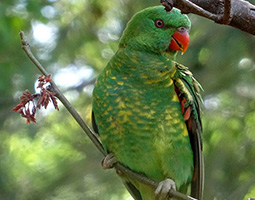Trichoglossus chlorolepidotus
Description

The Scaly-breasted Lorikeet, found in eastern Australia, is mostly emerald green with a bluish tinge on the crown, while the feathers of the back of the neck, throat and breast are yellow, broadly edged with green, giving a scaly appearance. They have orange-red eyes and their beaks are dark coral-red. Their legs are generally grey-brown. Male and female are similar, as are juveniles, although they have a shorter tail.
Scaly-breasted lorikeets have a loud, screeching or chattering call, similar to a Rainbow Lorikeet but higher pitched. They frequent most timbered areas and are often seen in gardens and parklands – even in large cities, often grouped together in mixed flocks with other species of nectar-eating birds.
Breeding occurs almost all year round except March and April, in a nest in a tree hollow high above the ground. Usually two eggs are laid on a bed of decayed wood, which is incubated by the female even though the male shares the hollow space. Both adults feed the young which leave the nest six to eight weeks after hatching.
Adaptations
- Predominantly green plumage blends so well with foliage that the bird is hard to detect
- Fly swiftly and in a straight path to avoid predation
- Brush-tipped tongue which is used to extract nectar and pollen from flowering trees
Feeding relationships
- What I eat: mainly nectar and pollen, but will also eat flowers, berries, fruit and insects
- What eats me: Peregrine falcons, Brown falcons, Whistling kites, Pythons
Interesting facts
Scaley-breasted Lorikeets are very fond of cultivated fruits and often cause damage in orchards. They also raid sorghum and maize crops to feed on unripe milky grain.
Acknowledgements: Birdlife, Australian Museum, Wikipedia